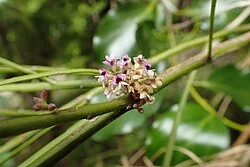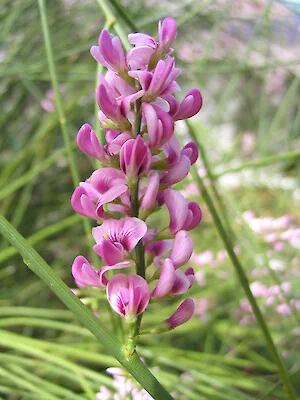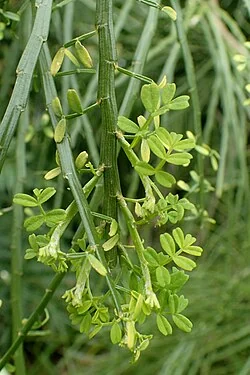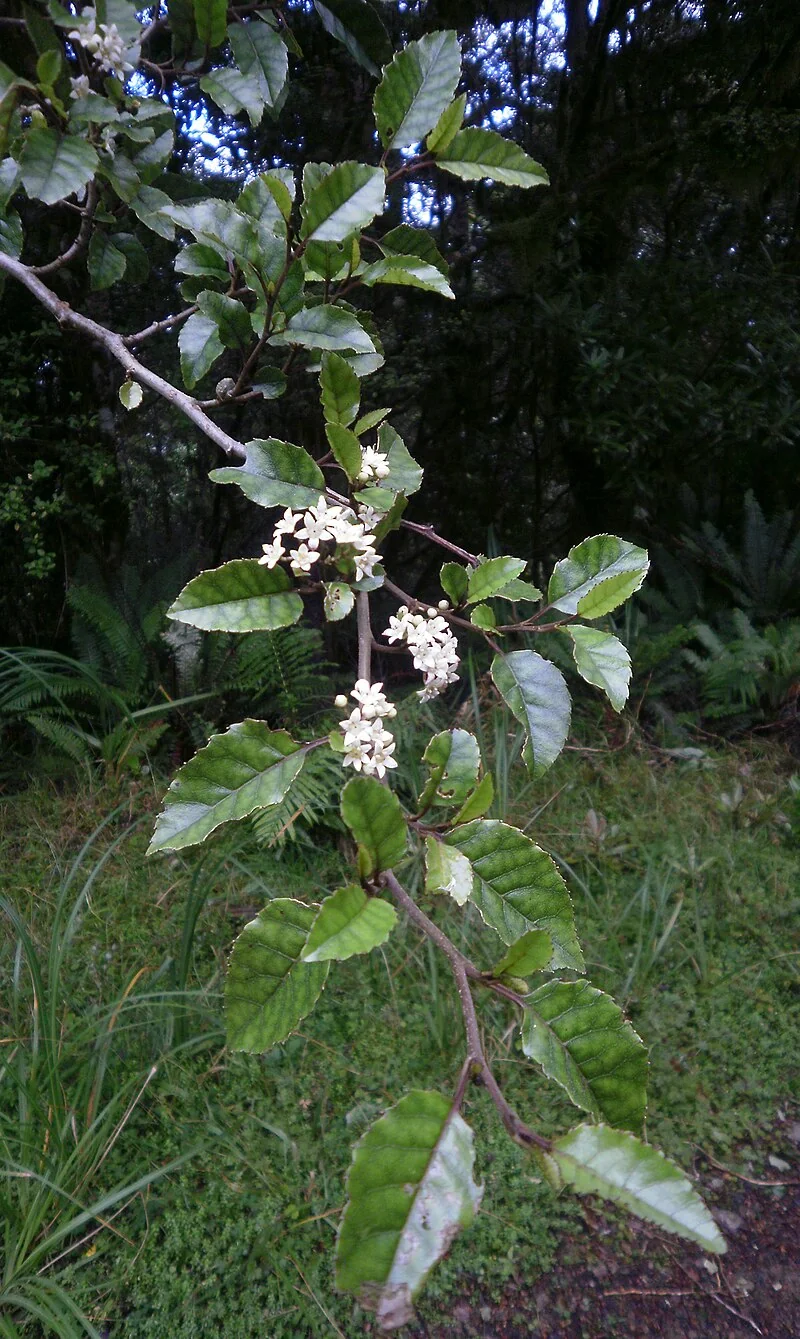
Rautahi
Carex geminata
Explore more NZ native plant guides in our index .
Introduction
About Rautahi
Carex geminata , known by its Māori name Rautahi or colloquially as Cutty Grass, is a robust rhizomatous sedge endemic to New Zealand's North, South, and Stewart Islands that represents one of the country's most important wetland restoration species. This impressive native plant reaches 0.5-1.2 m in height with bright green to yellow-green triangular culms and numerous wide leaves featuring distinctively scabrid (rough) margins that give it the "cutty grass" common name. Forming large colonies through creeping rhizomes, Rautahi produces characteristic yellow-green to dark-green "worm-like" pendulous spikes from September to December, thriving in freshwater wetlands from coastal to lower montane zones where it serves as a keystone species for stream bank stabilization, nitrogen runoff reduction, and large-scale wetland restoration projects throughout Aotearoa.

Plant Description
Carex geminata , known by its Māori name Rautahi or colloquially as Cutty Grass, is a robust rhizomatous sedge endemic to New Zealand. It forms large, wide-spreading patches, typically growing 50-100 cm high, with bright green to yellow-green triangular culms and numerous wide leaves that have distinctively sharp, scabrid (rough) edges. It produces delicate, brownish flower spikes in spring and summer. This sedge is commonly found in freshwater wetlands, along river and stream banks, and lake margins, and is valued for its ability to stabilize soil and control erosion.
Quick Facts
| Scientific Name | Nestegis lanceolata |
|---|---|
| Height | 15-20 m |
| Spread | 3-5 m |
| Water Needs | Moderate |
| Light | Full sun to part shade |
| Frost Tolerance | Moderate |
| Salt Tolerance | Moderate |
| Growth Rate | Medium |
| Lifespan | Long |
Climate Best Suited to
Carex geminata demonstrates exceptional adaptability across New Zealand's diverse wetland environments, naturally occurring from coastal to lower montane zones throughout the North, South, and Stewart Islands in freshwater wetlands, river and stream banks, lake margins, damp seepages, pond margins, and forest clearings. This hardy endemic sedge thrives in New Zealand's temperate maritime climate, tolerating both flooding and varying moisture conditions while performing best in fertile to mid-fertile wetland sites with full sun exposure. Its natural distribution across multiple climate zones reflects remarkable resilience to seasonal variations, making it ideal for restoration projects in diverse geographical locations.
Regional Suitability
| City | Climate Suitability |
|---|---|
| Whangārei | Ideal |
| Auckland | Ideal |
| Hamilton | Ideal |
| Tauranga | Ideal |
| Rotorua | Ideal |
| Gisborne | Ideal |
| New Plymouth | Ideal |
| Napier | Ideal |
| Whanganui | Ideal |
| Palmerston North | Ideal |
| Wellington | Ideal |
| Nelson | Ideal |
| Christchurch | Ideal |
| Dunedin | Ideal |
| Invercargill | Ideal |
Habitat
Carex geminata , known by its Māori name Rautahi or colloquially as Cutty Grass, is a robust rhizomatous sedge endemic to New Zealand, found throughout the North, South, and Stewart Islands. It primarily inhabits freshwater wetlands, including river and stream banks, lake margins, damp seepages, pond margins, and forest clearings.
This impressive native plant thrives in moist to wet soils and is well-suited to areas with waterlogging and flooding, often growing in shallow water. While typically a hydrophyte (a plant that grows in water), it can occasionally be found in non-wetland uplands. Carex geminata prefers fertile to mid-fertile wetlands and generally does best in full sun, though it can tolerate some shade. Its dense root system makes it exceptionally effective for erosion control, particularly along waterways. It is also resilient to wind and frost and can tolerate coastal conditions, although it prefers sheltered locations.
Plant Conservation
Carex geminata is an endemic New Zealand sedge found across North, South, and Stewart Islands, having undergone assessment under the New Zealand Threat Classification System during the comprehensive 2022-2023 review of native vascular plant taxa. This Twin Sedge demonstrates adaptability across diverse wetland environments from coastal to montane elevations.
The species benefits from its relatively wide distribution and ability to colonize various wetland habitats including swamps, lakeshores, and stream margins. Its ecological role as a dominant emergent plant in many freshwater systems contributes to wetland stability and provides important habitat for native wildlife, particularly waterbirds and aquatic invertebrates.
Like many New Zealand wetland species, Twin Sedge faces potential challenges from habitat modification, drainage of wetlands, and competition from invasive aquatic and semi-aquatic plants. The species' dependence on permanently moist to wet conditions makes it particularly vulnerable to hydrological changes and water management practices that affect wetland water levels.
Conservation efforts benefit from the species' use in wetland restoration projects and its cultivation for erosion control along waterways. Its strong rhizomatous growth habit makes it valuable for stabilizing banks and creating natural habitat corridors, while cultivation in appropriate water gardens helps maintain genetic diversity and reduces collection pressure on wild populations.
Growing Requirements
Soil Requirements
White maire (Nestegis lanceolata) is remarkably adaptable to different soil conditions, thriving in well-drained environments. It can tolerate a variety of soil types, from sandy to loamy, and prefers a neutral to slightly acidic pH. Good drainage is crucial to prevent root rot, ensuring healthy growth and development.
- Tolerates a wide range of soil types from clay to sandy
- Prefers well-draining soils but can handle occasional waterlogging
- Thrives in moderately fertile soils but will grow in poor soils too
- Can tolerate slightly acidic to slightly alkaline pH
- Handles coastal conditions including salt spray
Light Requirements
White maire (Nestegis lanceolata) thrives in a variety of light conditions, from full sun to partial shade. Optimal growth and flowering are typically achieved in locations receiving ample sunlight throughout the day. However, it can also tolerate some shade, especially in hotter climates, where it benefits from protection during the most intense afternoon sun.
- Full sun for optimal growth and form
- Can tolerate partial shade but may develop a leggier form
- At least 6 hours of direct sunlight daily is ideal
- Northern or eastern exposures work well in garden settings
Water Requirements
Once established, White maire (Nestegis lanceolata) is remarkably drought-tolerant, requiring minimal supplemental watering. During its establishment phase, consistent moisture is crucial to encourage strong root development. Mature plants can withstand dry periods, but regular watering during prolonged droughts will promote healthier growth and more abundant flowering.
- Moderate watering during establishment (first 1-2 years)
- Drought-tolerant once established
- Can handle periods of soil saturation
- Reduce watering in winter when growth slows
- Signs of overwatering include yellowing leaves and crown rot
Planting Guide
-
When to Plant
Plant in autumn or spring.
-
Site Preparation
Choose a sunny or partially shaded site with wet, fertile soil.
-
Planting and Aftercare
Dig a hole twice the width of the pot. Place the plant in the hole and backfill with soil. Water well and apply a layer of mulch.
Ecological Significance
Carex geminata , known by its Māori name Rautahi or colloquially as Cutty Grass, is a robust, rhizomatous sedge endemic to New Zealand. It holds significant ecological importance, particularly in freshwater wetland ecosystems, where it plays several crucial roles.
- Wetland Restoration and Stabilization: Carex geminata is highly valued for environmental plantings, especially in wetland restoration projects. It thrives in moist to wet soils and has a wide-spreading habit, making it excellent for establishing and stabilizing stream banks, wetlands, and swamps. Its ability to tolerate waterlogging and flooding further enhances its suitability for these areas.
- Erosion Control: This sedge contributes significantly to erosion control due to its robust growth and ability to form large patches. Its creeping rhizomes help it spread effectively and bind soil, preventing soil loss in vulnerable areas.
- Habitat Contribution: Carex geminata is a common component of wetland and swampy plant communities, often found alongside species like Apodasmia similis , Carex maorica , Carex secta , Carex virgata , Phormium tenax , and Eleocharis acuta . It provides essential ecological support in these habitats, offering shelter and contributing to the overall biodiversity.
- Resilience: It is resilient to wind and frost and can tolerate some coastal exposure, although it prefers sheltered locations. It can also grow in a wide range of soil types, including heavy and loamy soils, showcasing its adaptability.
- Nutrient Management: Carex geminata is suitable for planting in areas for effluent disposal or to reduce nitrogen runoff in wetter farm areas, contributing to water quality improvement.
- Attractiveness to Insects: The plant's foliage is attractive to insects, contributing to local biodiversity and supporting pollinator populations.
- Conservation Status: Currently, Carex geminata is classified as "Regionally Not Threatened" in areas like Auckland and Otago, indicating a stable population within its native range.
Uses and Significance
Garden Uses
- Specimen tree for visual impact
- Suitable for native gardens and restoration projects
- Enhances native garden aesthetics and biodiversity
- Provides architectural accent with its unique structure
- Effective for erosion control on slopes and banks
Ecological Value
Ecologically, White maire (Nestegis lanceolata) plays a crucial role in supporting native ecosystems. Its fruits are a food source for birds, especially the kereru, contributing to the local biodiversity and food web.
- Provides a vital food source for native birds, especially the kereru
- Offers habitat and nesting sites for various fauna
- Contributes to soil stabilization and nutrient cycling
- Forms natural shelter belts, protecting other species
Landscaping Uses
Carex geminata , also known as Rautahi or Cutty Grass, is a versatile New Zealand native sedge with several valuable landscaping applications, particularly in wetland and riparian areas. It is valued for its robust growth, resilience, and ability to thrive in challenging moist environments.
- Ground Cover and Mass Planting: It is commonly mass planted as an effective ground cover, especially on banks or in areas where a lush, natural aesthetic is desired. Its ability to spread through creeping rhizomes allows it to form large colonies, providing excellent coverage.
- Wetland and Riparian Plantings: Carex geminata is excellent for establishing and restoring wetland areas, stabilizing stream banks, and preventing erosion due to its tolerance for waterlogging and flooding. It is ideal for rain gardens, pond margins, and other damp environments.
- Borders and Mixed Plantings: It can be incorporated into borders or mixed plantings, adding graceful texture and movement to the landscape. Its vibrant green foliage provides a natural contrast to other plants.
- Commercial Gardens: This hardy grass is suitable for gardens around commercial buildings, especially in wetter areas like drains, as it is low-maintenance and tolerates some neglect once established.
- Effluent Disposal and Nitrogen Runoff Reduction: It can be used in wetter areas of farms for effluent disposal or to reduce nitrogen runoff, contributing to environmental management.
- Naturalistic and Native Gardens: Its natural habitat in damp or swampy ground throughout New Zealand makes it perfect for naturalistic or native garden designs, helping to recreate authentic New Zealand landscapes.
Carex geminata is favored by landscape designers for its versatility, hardiness, and aesthetic appeal. It thrives in moist, well-drained soils and can tolerate full sun to partial shade, frost, wind, and coastal conditions. While its spreading habit and sharp-edged leaves might make it less suitable for typical garden beds, it is highly valued for large-scale environmental and wetland projects.
Seasonal Care Calendar
Spring
In spring, White maire (Nestegis lanceolata) begins its active growth phase. New foliage emerges, and it's an ideal time for planting new specimens or propagating. Ensure adequate moisture and monitor for early signs of pests.
- New growth begins with fresh foliage development
- Apply a balanced, slow-release fertilizer if desired
- Excellent time for planting new specimens or dividing offsets
- Monitor for new pest activity and address promptly
Summer
Summer is the peak growing season for White maire (Nestegis lanceolata), often accompanied by flowering. Consistent watering is important, especially for young plants, to support vigorous growth and prevent stress during dry periods.
- Flowering typically occurs in early to mid-summer (November-January)
- Water young trees regularly during extended dry periods
- Avoid heavy pruning during the active growing season
Autumn
During autumn, White maire (Nestegis lanceolata) prepares for the cooler months. Fruits or berries develop, providing food for native birds. It's also a good time for planting and general garden cleanup.
- Fruits or berries develop and ripen (December-February), attracting birds
- Natural leaf shedding occurs as part of its growth cycle
- Good time for planting new specimens to establish before winter
- Clean up fallen leaves if a tidy appearance is desired
Winter
Winter is generally a dormant period for White maire (Nestegis lanceolata). Minimal care is required, though young plants may benefit from protection in colder regions. This is an opportune time for any necessary structural pruning.
- Generally dormant with minimal growth activity
- No special winter protection needed in most mild climates
- Suitable time for structural pruning if required
- Fallen leaves can be left as mulch or removed for tidiness
When to Prune and How Much
White maire (Nestegis lanceolata) generally requires minimal pruning to maintain its natural form and health. Pruning should focus on removing dead or damaged growth and shaping the plant as needed.
- Remove dead, damaged, or diseased branches at any time of year
- Light formative pruning when young helps establish good structure
- To create a multi-trunked specimen, cut the main stem to encourage branching
- Fallen leaves can be removed for a tidier appearance, or left as natural mulch
- If necessary, lower branches can be removed to create clearance underneath
- Major pruning is best done in late winter to early spring before new growth
Always use clean, sharp tools for pruning to minimize the risk of disease and ensure clean cuts. The plant often responds well to pruning with vigorous new growth, contributing to a fuller, healthier appearance.
How to Grow Rautahi
From Rhizome Division
Rhizome division represents the most efficient and reliable propagation method for Rautahi, taking advantage of this robust wetland sedge's natural colony-forming habit through extensive underground rhizome systems that create large patches over time. This impressive native wetland species develops vigorous creeping rhizomes that naturally spread to establish substantial colonies, making division an exceptionally straightforward propagation method for restoration projects and wetland establishment. The robust rhizomatous growth system makes Rautahi particularly valuable for large-scale wetland restoration where extensive plant coverage is required, as single plantings naturally expand to cover substantial areas within a few growing seasons. The optimal timing for division is during spring or autumn when plants are either emerging from or entering dormancy, providing divided sections with favorable conditions for rapid establishment before facing environmental stress. Begin by identifying established colonies that have developed sufficient size and rhizome density, typically colonies that are at least 2-3 years old and showing vigorous spreading growth throughout the growing area. Use a sharp spade or garden fork to carefully lift sections of the colony, working systematically to preserve the extensive rhizome network that provides the foundation for rapid establishment in new locations. Rautahi develops a substantial underground rhizome system that extends well beyond the visible foliage, creating a network of growing points that can be divided into numerous independent plants. Once lifted, examine the rhizome structure to identify natural division points where healthy growing sections have developed, typically visible as areas with both vigorous rhizome development and strong shoot emergence. Use clean, sharp tools to divide rhizome sections, ensuring each division includes both healthy rhizome material and sufficient shoot development to support establishment in wetland conditions. Divisions should be substantial enough to establish quickly in wet conditions, with sections containing multiple growing points providing the best establishment success for restoration projects. Each division should include adequate rhizome mass and multiple growing shoots to support the plant's adaptation to consistently wet growing conditions typical of stream margins and wetland sites. Replant divisions immediately in suitable wetland locations at the same depth they were previously growing, spacing them according to desired coverage and the specific requirements of the restoration project. Choose locations that provide the consistently wet to flooded conditions essential for this wetland specialist, ideally in areas with reliable water sources such as stream margins, pond edges, or constructed wetland systems. Water thoroughly after planting and maintain consistent moisture throughout establishment, as this species requires reliable water availability to develop the extensive rhizome systems that anchor it in wetland soils and provide long-term colony stability.
From Seeds
Seed propagation provides an authentic and economical method for growing Rautahi that maintains genetic diversity essential for restoration projects while taking advantage of this species' prolific seed production and natural dispersal mechanisms. This important wetland species produces abundant viable seeds through distinctive yellow-green to dark-green pendulous, worm-like spikes that develop during the extended September to December flowering period, followed by October to March fruiting that provides multiple opportunities for seed collection. The species' natural seed dispersal through wind and animal vectors demonstrates the viability of seed propagation, with new populations often establishing naturally in suitable wetland sites downstream from established colonies. Collect fresh seeds from the distinctive pendulous spikes during the fruiting period when seeds have fully matured but not yet begun to disperse naturally, cutting entire seed heads with clean secateurs and placing them in paper bags to complete drying in well-ventilated conditions. Seeds maintain excellent viability when collected fresh and should be sown immediately for optimal germination results, as this wetland species responds well to direct seeding in suitable habitat conditions. The prolific seed production makes Rautahi excellent for large-scale direct seeding in wetland restoration projects where establishing extensive coverage through natural regeneration is preferred over individual plant installation. Prepare suitable seed beds in consistently wet to flooded locations that replicate the stream margins, pond edges, and wetland sites where this species naturally establishes from seed. Surface-sow seeds directly onto wet, exposed soil or shallow water margins where they can germinate in the consistently moist conditions essential for establishment success. Seeds benefit from the natural stratification that occurs in wetland environments during winter, with germination typically occurring during spring as temperatures warm and daylight hours increase. Maintain consistently wet conditions throughout the germination and establishment period, as young seedlings require reliable moisture to develop the extensive root systems necessary for wetland adaptation. The natural colonization ability means that successful seeding often results in expanding populations that spread through both rhizome development and continued seed production, creating sustainable wetland communities over time. Young plants develop relatively slowly initially while establishing the extensive rhizome systems characteristic of mature colonies, but once established they spread vigorously to create substantial coverage. This method is particularly valuable for restoration projects where creating genetically diverse, self-sustaining wetland communities is more important than achieving immediate plant coverage, as seed-grown populations often show better long-term adaptation to local wetland conditions.
From Wetland Construction
Wetland construction establishment provides a specialized approach to growing Rautahi that focuses on creating suitable wetland habitat while establishing sustainable plant communities for long-term ecosystem function and restoration success. This method is particularly valuable for large-scale restoration projects, agricultural effluent systems, and stormwater management installations where Rautahi serves both ecological and practical functions including nitrogen runoff reduction and stream bank stabilization. The species' role as a keystone wetland species makes it essential for creating functional wetland ecosystems that provide habitat, water quality improvement, and erosion control over extended periods. Begin by designing wetland construction projects that provide the consistently wet to flooded conditions essential for Rautahi establishment, including consideration of water sources, drainage patterns, and seasonal flooding regimes that support long-term plant community development. Prepare construction sites by creating appropriate topography with varied water depths and moisture gradients that accommodate the natural habitat preferences of this wetland specialist, typically including shallow water areas, saturated soil zones, and periodic flooding areas. Source plant material through a combination of rhizome divisions from nearby populations, locally-grown seedlings, and direct seeding to ensure genetic diversity and adaptation to local wetland conditions over time. Establish initial plantings during optimal windows in autumn or early spring when water levels are naturally high and establishment stress is minimized, allowing maximum development time before facing summer stress conditions. Space plants according to the specific restoration goals and site hydrology, with closer spacing for rapid coverage and erosion control, or wider spacing to allow natural spreading and colony development over time. Create diverse wetland microhabitats by varying planting zones according to water depth, soil saturation, and exposure conditions to accommodate the full range of conditions where Rautahi naturally thrives. Integrate with complementary native wetland species such as Phormium tenax and other endemic sedges to create diverse plant communities that provide enhanced habitat value and ecosystem resilience. Monitor establishment success and water level management to ensure suitable growing conditions during critical establishment periods, particularly during the first two growing seasons when rhizome development determines long-term success. Allow natural processes including rhizome spreading and seed dispersal to expand initial plantings, creating dynamic wetland communities that evolve over time while maintaining the essential ecological functions that Rautahi provides in authentic New Zealand wetland systems. This approach requires longer time frames for full development compared to conventional planting methods, but creates resilient and sustainable wetland systems that provide lasting environmental benefits including water quality improvement, wildlife habitat, and cultural landscape restoration.
Pests and Diseases
Naturally Hardy
Generally pest and disease free.
Watch for scale and fungal leaf spots; improve airflow and avoid over-watering to limit disease pressure.
Cultural Significance
Rautahi (Carex geminata) was used by Māori for weaving and thatching. The plant's presence in wetlands was an indicator of a healthy ecosystem.
Bonus Tip
The name "geminata" means "twin" or "paired," referring to the paired female spikelets that are a key characteristic of this species. This makes it a great plant for those interested in the finer details of New Zealand's native flora.







